Miele KF2981VI Installation and Operation Guide

Operating and Installation Instructions
Fridge-freezer Combination
To prevent accidents and machine damage, read these instructions before installation or use.
en-US, CA |
M.-Nr. 10 785 190 |

Contents |
|
IMPORTANT SAFETY INSTRUCTIONS ............................................................ |
6 |
Caring for the environment .............................................................................. |
14 |
Installation.......................................................................................................... |
15 |
Installation location ............................................................................................. |
15 |
Climate class .................................................................................................. |
15 |
Installation notes ................................................................................................. |
16 |
Adjoining cabinetry/units................................................................................ |
16 |
Load-bearing capacity of the niche floor ....................................................... |
17 |
Ventilation....................................................................................................... |
17 |
Side-by-side................................................................................................... |
18 |
Specifications for the plumbed water connection............................................... |
20 |
Installation dimensions........................................................................................ |
21 |
Dimensions when the appliance door is open (opening angle 90°/115°)....... |
23 |
Dimensions of the cabinet front .......................................................................... |
24 |
Building in the appliance ..................................................................................... |
25 |
Before starting................................................................................................ |
25 |
Tools required................................................................................................. |
26 |
Weight of cabinet fronts ................................................................................. |
26 |
Aligning the installation niche......................................................................... |
27 |
Checking the installation space ..................................................................... |
27 |
Before installation........................................................................................... |
28 |
Preparing the installation niche ...................................................................... |
29 |
Pushing the appliance into the niche ............................................................. |
32 |
Aligning the refrigeration appliance................................................................ |
33 |
Securing the appliance in the niche ............................................................... |
36 |
Preparing the cabinet fronts ........................................................................... |
38 |
Securing and aligning the cabinet fronts........................................................ |
40 |
Securing the covers ....................................................................................... |
45 |
Securing the toe-kick ventilation grille and toe-kick cover ............................ |
47 |
Limiting the opening angle of the appliance doors ........................................ |
48 |
Water connection ................................................................................................ |
49 |
Information on the fresh water connection .................................................... |
49 |
Installing the water hose to the appliance...................................................... |
50 |
Electrical connection ........................................................................................... |
51 |
Saving energy .................................................................................................... |
53 |
Guide to the appliance...................................................................................... |
55 |
Main screen......................................................................................................... |
57 |
Settings mode ................................................................................................ |
58 |
2

Contents |
|
Accessories ....................................................................................................... |
60 |
Accessories supplied .......................................................................................... |
60 |
Optional accessories........................................................................................... |
61 |
Before first use .................................................................................................. |
62 |
Opening and closing the Fridge Zone door.................................................... |
62 |
Choosing the right Door Assistant (Push2Open/Pull2Open) ........................ |
62 |
Adhering labels for the MasterFresh zone...................................................... |
62 |
Inserting the Active AirClean filters ................................................................ |
64 |
Operating the refrigeration appliance.................................................................. |
64 |
Starting up for the first time ........................................................................... |
64 |
Switching on and off ......................................................................................... |
66 |
Turning off for longer periods of time .................................................................. |
67 |
Selecting additional settings............................................................................ |
68 |
Switching Keypad Lock / on or off .............................................................. |
68 |
Switching Eco Mode on or off........................................................................ |
69 |
Performing a Self Test ..................................................................................... |
70 |
Switching Condensation Protection on and off .............................................. |
71 |
Switching on the Door Assistant ..................................................................... |
71 |
Switching off the Door Assistant ..................................................................... |
73 |
Miele@home ........................................................................................................ |
73 |
Switching off Demo Mode ................................................................................ |
77 |
Resetting the settings to their default settings .............................................. |
78 |
Switching Vacation mode on or off................................................................ |
81 |
Switching Sabbath Mode on or off .................................................................. |
82 |
Switching on, switching off or resetting Water Filter Display ......................... |
83 |
Switching on, switching off, or resetting the Display Active AirClean Filter ... |
85 |
The correct temperature................................................................................... |
87 |
... in the Fridge Zone and in the MasterFresh zone ............................................. |
87 |
Automatic cold air circulation (DynaCool) ........................................................... |
87 |
... in the Freezer Zone.......................................................................................... |
87 |
Setting the temperature....................................................................................... |
88 |
Temperature range ......................................................................................... |
88 |
Using Automatic SuperCool and SuperFreeze ............................................... |
89 |
Temperature and door alarm............................................................................ |
91 |
Adjusting the interior fittings............................................................................ |
93 |
Moving the shelves in the appliance door........................................................... |
93 |
Moving the adjustable shelves ............................................................................ |
93 |
Removing the hanging drawer ............................................................................ |
94 |
3

Contents |
|
Removing compartments from the Fridge Zone ................................................. |
95 |
Removing the freezer baskets............................................................................. |
95 |
Removing the dividing panel (depending on the model)................................ |
96 |
Removing the ice cube tray................................................................................. |
96 |
Storing food in the refrigerator section........................................................... |
97 |
Different storage zones ....................................................................................... |
97 |
Food which is not suitable for storage in the refrigerator section ....................... |
98 |
Notes on buying food.......................................................................................... |
99 |
Storing food correctly.......................................................................................... |
99 |
Storing food in the MasterFresh zone ............................................................. |
100 |
MastertFresh zone............................................................................................... |
100 |
Humidity-controlled compartment with moisture regulator ........................... |
100 |
Dry compartment with low temperature......................................................... |
102 |
Freezing and storing food................................................................................. |
104 |
Maximum freezing capacity ................................................................................ |
104 |
What happens when you freeze fresh food?....................................................... |
104 |
Storing frozen food.............................................................................................. |
105 |
Home freezing ..................................................................................................... |
105 |
Before placing food in the freezer ....................................................................... |
106 |
Placing food in the Freezer Zone......................................................................... |
106 |
Making ice cubes .............................................................................................. |
108 |
Automatic defrosting ........................................................................................ |
110 |
Cleaning and care ............................................................................................. |
111 |
Cleaning agents................................................................................................... |
111 |
Before cleaning the appliance............................................................................. |
112 |
Interior and accessories ...................................................................................... |
112 |
Cleaning the door seal ........................................................................................ |
113 |
Cleaning the ventilation gaps .............................................................................. |
113 |
Replacing the Active AirClean filters ................................................................... |
113 |
After cleaning ...................................................................................................... |
113 |
Water filter.......................................................................................................... |
115 |
Changing the water filter ..................................................................................... |
116 |
Using an external water filter............................................................................... |
117 |
Lead-free certificate ............................................................................................ |
119 |
Frequently Asked Questions ............................................................................ |
120 |
Causes of noises ............................................................................................... |
130 |
4

|
Contents |
Customer Service.............................................................................................. |
131 |
Contact in the event of a fault ............................................................................. |
131 |
Appliance warranty and product registration ...................................................... |
131 |
Declaration of conformity................................................................................. |
132 |
Copyrights and licenses ................................................................................... |
133 |
5
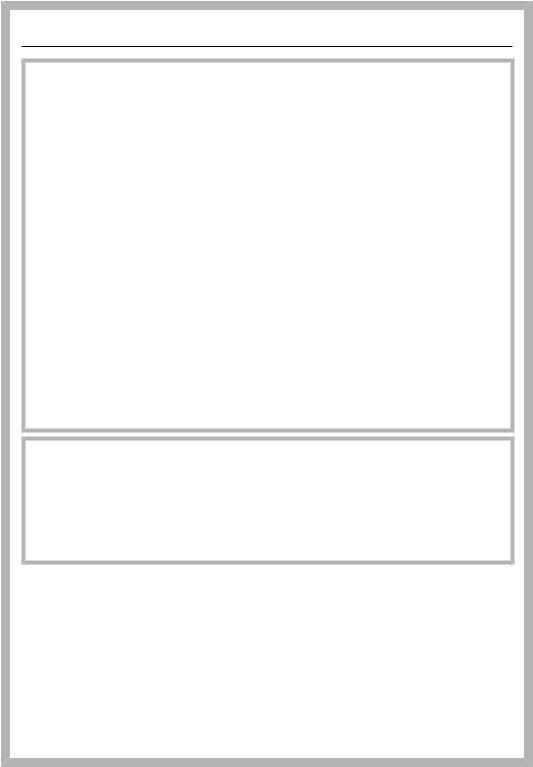
IMPORTANT SAFETY INSTRUCTIONS
This refrigeration appliance complies with current safety requirements. Inappropriate use can, however, lead to personal injury and material damage.
Please read the operating and installation instructions carefully before using the refrigeration appliance for the first time. They contain important information on safety, installation, use, and maintenance. This is to protect yourself from injury, and from damaging your refrigeration appliance.
Miele expressly and strongly advises that you read and follow the instructions in the chapter on installing the refrigeration appliance, as well as the IMPORTANT SAFETY INSTRUCTIONS.
Miele cannot be held liable for injury or damage caused by noncompliance with these instructions.
Keep these instructions in a safe place and pass them on to any future owner.
Danger of injury!
This appliance is very heavy and can tip forwards when the doors are open.
Keep the appliance doors shut until the appliance has been built in and secured in its housing in accordance with these operating and installation instructions.
6

IMPORTANT SAFETY INSTRUCTIONS
Appropriate use
This appliance is intended for use in domestic households and similar residential environments such as
– staff kitchen areas in shops, offices and other working environments
– farm houses and by clients in hotels, motels and other residential type environments
– bed and breakfast type environments
– catering and similar non-retail applications.
This appliance is not intended for use outdoors, in damp environments or in places exposed to rain.
This appliance is intended for domestic use only for cooling and storing food and drink as well as for storing deep frozen food, freezing fresh food and for making ice.
Any other usage is not supported by the manufacturer and could be dangerous.
This refrigeration appliance is not suitable for storing and keeping cool medicines, blood plasma, laboratory preparations, or other similar substances or products that are subject to the Medical Device Directive. Incorrect use of the refrigeration appliance for such purposes may cause deterioration of the items stored. The refrigeration appliance is also not suitable for use in areas where there is a risk of explosion.
Miele cannot be held liable for damage resulting from incorrect or improper use or operation.
This refrigeration appliance may only be used by people (including children) with reduced physical, sensory, or mental capabilities or lack of experience and knowledge if they are supervised while using it.
The refrigeration appliance may only be used by these people without supervision if they have been shown how to use it in a safe way and recognize and understand the consequences of incorrect operation.
7

IMPORTANT SAFETY INSTRUCTIONS
Safety with children
To reduce the risk of injury, do not allow children to play in, on or near the appliance.
The door hinges can cause injury. Keep children well away at all times.
Ensure that any packing material is disposed of safely and kept out of the reach of children. DANGER of suffocation!
Technical safety
The coolant circuit has been checked for leaks. The refrigeration appliance complies with statutory and regulatory requirements..
To avoid the risk of damage to the appliance, make sure that the connection data (fuse rating, frequency and voltage) on the data plate corresponds to the household supply.
Check that this is the case before connecting the appliance. Consult a qualified electrician if in any doubt.
The electrical safety of the appliance can only be guaranteed when correctly grounded. It is essential that this standard safety requirement is met. If in any doubt please have the electrical installation tested by a qualified electrician.
Reliable and safe operation of this appliance can only be assured if it has been connected to the electricity supply.
The outlet must not be concealed behind the appliance and must be easily accessible so that the appliance can be quickly disconnected from the electrical supply in case of an emergency.
If the power cord supplied is damaged, it must only be replaced by an original part to prevent a hazard for the user. Miele can only guarantee the safety of the appliance when original Miele parts are used.
The electrical outlet must be properly grounded.
8

IMPORTANT SAFETY INSTRUCTIONS
Do not connect the appliance to the electrical supply with a power bar or extension cord. These are a fire hazard and do not guarantee the required safety of the appliance.
If moisture gets into electrical components or into the power cord, it could cause a short circuit. Therefore, do not operate the machine in areas where there may be moisture or splashing water (e.g., garages, laundry rooms).
This appliance must not be installed and operated in mobile installations (e.g. on a ship).
Do not use a damaged appliance. It could be dangerous. Check the appliance for visible signs of damage.
For safety reasons, this appliance may only be used after it has been built in.
The machine must be disconnected from the power supply during installation, maintenance, and repair work, and installation work on the fresh water connection. The machine is only completely isolated from the power supply when:
-the fuses have been switched off, or
-the circuit breaker has been removed completely, or
-the power cord has been unplugged. Pull on the plug and not on the power cord when disconnecting it from the power supply.
Unauthorized installation, maintenance, and repairs, or a faulty fresh water connection can cause considerable danger for the user. Installation, maintenance, and repairs, installation work on the fresh water connection, and all repairs on the ice/water outlet must only ever be carried out by a Miele authorized technician.
Any manufacturer's warranty will be void if the appliance is not repaired by a Miele approved service technician.
9

IMPORTANT SAFETY INSTRUCTIONS
Defective components should only be replaced by Miele original parts. Only with these parts can the manufacturer guarantee the safety of the appliance.
Miele cannot be held liable for damage caused by a faulty connection to the fresh water supply.
The ice cube maker must only be connected to a cold water line.
DANGER of injury! Never tamper with the movable components on the ice cube maker or the element on the ice cube maker.
Correct use
The refrigeration appliance is designed for use within a specific climate class (room temperature range). Do not use in a climate class for which it is not designed. A lower room temperature will cause the compressor to switch off for longer periods, meaning that the refrigeration appliance is unable to maintain the required temperature.
WARNING! DANGER of overheating! Do not cover or block the air vents. This can impair the efficiency of the appliance, increase the power consumption and cause damage to the appliance.
If storing food which contains a lot of fat or oil in the appliance, make sure that it does not come into contact with plastic components as this could cause stress cracks or break the plastic.
Risk of fire and explosion. Do not store any explosive materials or products containing flammable propellants (e.g., spray cans) in the appliance. Electrical components can cause flammable mixes of gases to ignite.
Risk of explosion. Do not operate any electrical equipment (e.g., an electric ice-cream maker) inside the refrigeration appliance. Risk of sparking and explosion.
10

IMPORTANT SAFETY INSTRUCTIONS
Do not store cans or bottles containing carbonated drinks or liquids which could freeze in the freezer. The cans or bottles could explode.
DANGER of injury and damage to the appliance.
When cooling drinks quickly in the freezer, make sure bottles are not left in for more than one hour; otherwise they could burst, causing injury or damage.
Risk of injury. Never handle frozen food or the metal parts of the appliance with wet hands. Your hands may freeze to the frozen food or to the metal.
Risk of injury. Do not take ice cubes out with your bare hands and never place ice cubes or ice pops in your mouth straight from the freezer section. The very low temperature of the frozen food can cause frost burn to the lips and tongue.
Do not refreeze partially or fully defrosted food. Consume defrosted food as soon as possible, as it will lose its nutritional value and spoil if left for too long. Defrosted food may only be refrozen after it has been cooked.
When eating stored food, there is a danger of food poisoning. Storage times will depend on several factors, including the freshness and quality of the food, as well as the temperature at which it is stored. Observe the manufacturer's “use-by” dates and storage instructions.
Use only genuine original Miele parts. If parts or accessories from other manufacturers are used, the warranty may become invalid.
11

IMPORTANT SAFETY INSTRUCTIONS
Cleaning and maintenance
Do not use any oil or grease on the door seals. They can cause the seals to deteriorate over time.
Never use a steam cleaner to clean the appliance.
The steam can reach the electrical components and cause a short circuit.
Sharp edged or pointed objects will damage the evaporator, causing irreversible damage to the appliance. Do not use sharp edged or pointed objects to
-remove frost or ice,
-separate frozen foods or remove ice trays.
Never place electric heaters or candles in the appliance to defrost it. These can damage the plastic parts.
Do not use defrosting sprays or de-icers, as they could contain substances which could damage the plastic parts or which might cause the build-up of gases and pose a danger to health.
12

IMPORTANT SAFETY INSTRUCTIONS
Transport
To avoid damage to the appliance, always transport it upright and in its packaging.
Risk of injury and damage. The refrigeration appliance is very heavy and must be transported by 2 people.
Disposal of your old appliance
Children could become trapped in the machine and could suffo-
cate.
-Remove the machine doors.
-Remove the drawers.
-Leave the adjustable shelves in the machine so children cannot climb inside.
DANGER of electric shock!
-Cut the plug off the power cord.
-Cut the power cord off the old appliance.
Dispose of them separately from the appliance.
Ensure that the appliance is not stored in the vicinity of gasoline or inflammable gases and liquids during and after disposal.
Make sure that the coolant pipework is not damaged during disposal to avoid uncontrolled leakage of oil and coolant (see data plate for coolant type).
Splashes of coolant can cause damage to the eyes. Be careful not to damage any part of the pipework while awaiting disposal, e.g. by
-puncturing the coolant channels in the evaporator,
-kinking any pipework,
-scratching the surface coating.
13

Caring for the environment
Disposal of packaging material
The packaging is designed to protect the appliance from damage during transportation. The packaging materials used are selected from materials which are environmentally friendly for disposal and should be recycled.
Ensure that any plastic wrappings, bags, etc. are disposed of safely and kept out of the reach of children. Return the packaging to your dealer.
Disposing of your old appli-
ance
Electronic and electrical appliances contain many valuable materials. They also contain certain materials, compounds, and components which were essential for their correct functioning and safety. These could be hazardous to your health and to the environment if disposed of with general waste or if handled incorrectly. Please do not, therefore, dispose of your old appliance with general waste.
Instead, please make use of officially designated collection and disposal points to dispose of and recycle electrical and electronic appliances. By law, you are solely responsible for deleting any personal data from the appliance prior to disposal.
Take care not to damage your refrigeration appliance’s pipework before or during transportation to an authorized collection depot.
This is to ensure that coolant in the cooling circuit and oil in the compressor is contained, and will not leak into the environment.
Please ensure that your old appliance poses no risk to children while being stored for disposal. For additional information, see “IMPORTANT SAFETY INSTRUCTIONS” in these operating and installation instructions.
14

Installation
Installation location
This appliance should be installed in a dry, well-ventilated room.
When deciding where to install your refrigeration appliance, please bear in mind that it will use more energy if installed near to a heater, a range, or another appliance that gives off heat. Direct sunlight should also be avoided. The higher the room temperature, the longer the compressor runs and the higher the energy consumption of the refrigeration appliance.
When installing the refrigeration appliance, please note the following:
-The electrical socket must be easily accessible in an emergency and not concealed behind the appliance.
-The plug and power cord must not touch the rear of the refrigeration appliance as they could be damaged by vibrations from the appliance.
-Do not plug in other appliances behind the refrigeration appliance.
If installation near a heat source is unavoidable, observe the following minimum distances between the appliance and the heat source:
-At least 1 1/4" (3 cm) to electric or gas stoves
-At least 11 3/4" (30 cm) to oil or coal-based stoves
If it is not possible to observe these minimum distances, an isolation plate must be installed between the refrigeration appliance and the heat source.
Climate class
The refrigeration appliance is designed for use within the climate class (room temperature range) SN-T. Do not use in a climate class for which it is not designed.
Climate class |
Room tempera- |
|
ture |
|
|
SN |
50°F to 90°F / |
|
10°C to 32°C |
|
|
N |
60°F to 90°F / |
|
+16°C to +32°C |
|
|
ST |
60°F to 100°F / |
|
+16 to +38°C |
|
|
T |
60°F to 109°F / |
|
+16 to +43°C |
|
|
A lower room temperature will cause the compressor to switch off for longer periods. This can cause the internal temperature in the refrigeration appliance to rise with the risk of food deteriorating and going off.
15
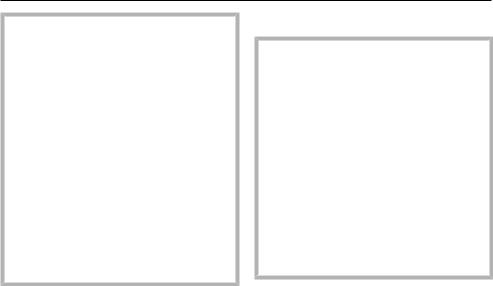
Installation
Risk of damage due to high humidity.
In environments with high humidity, condensation can build up on external refrigeration appliance panels, which can cause corrosion.
Install the refrigeration appliance in a dry and/or air-conditioned room with sufficient ventilation.
After installation, make sure that the appliance doors close properly, the ventilation gaps are not covered, and the refrigeration appliance has been installed in accordance with these operating and installation instructions.
Installation notes
Risk of damage and injury due to the refrigeration appliance tipping over.
This refrigeration appliance is very heavy and can tip forwards when the appliance door(s) is (are) open. Keep the appliance door(s) shut until the refrigeration appliance has been built in and secured in its housing in
accordance with these operating and installation instructions.
Due to its weight and size, the refrigeration appliance must be installed by two people.
Adjoining cabinetry/units
The appliance is screwed to the adjoining cabinetry/units to the side and above. For this reason, it is essential that all cabinets/units are fixed to the ground and/or wall.
16

Installation
Load-bearing capacity of the niche floor
To ensure the safe installation of the refrigeration appliance and to guarantee its correct functioning, the floor of the niche where the appliance is to be installed must be smooth and even.
It must be made from strong, rigid material.
Because the refrigeration appliance is extremely heavy when fully loaded, it is essential that the floor it stands on is able to bear its weight. If necessary, seek the advice of an architect or construction expert.
When fully loaded, the weight of the refrigeration appliance is approx.:
KF 2981 Vi |
1142 lbs |
|
(518 kg) |
Ventilation
Risk of fire and damage due to insufficient ventilation.
If the refrigeration appliance is not ventilated sufficiently, the compressor will run more frequently and for longer periods.
This causes increased energy consumption and an increased compressor operating temperature, which can result in damage to the compressor.
Please ensure that there is adequate ventilation around the refrigeration appliance.
Do not block the ventilation gaps. The ventilation gaps must never be obstructed.
17

Installation
Side-by-side
This appliance can be installed side-by- side with another refrigeration appliance. The following overview will show you which side-by-side installation options you have with your refrigeration appliance.
Depending on the installation situation, you will need the side-by-side installation kit for side-by-side installation (see “Accessories – Optional accessories”).
Instructions for installing refrigeration appliances side-by-side can be found in the side-by-side installation kit installation instructions.
. . . with partition wall
The wall a between the side-by-side appliances must be at least
5/8" (16 mm) thick.
If the door hinges of the refrigeration appliances are next to each other, you must take into account the thickness of the cabinet fronts and door handles so that the appliance doors do not collide and become damaged if they are opened at the same time.
The refrigeration appliances are secured individually in their installation niche using the supplied installation material.
If the partition wall a is narrower than 6 5/16" (160 mm), you will need the side panel heater from the side-by-side installation kit to prevent condensation from forming and any resulting damage.
18

Installation
When planning installation niches, please note that the niche into which the refrigeration appliance with the side panel heater is installed must be
3/16" (4 mm) wider (see “Installation
– Building-in dimensions”).
If the partition wall a is thicker than
6 5/16" (160 mm), you do not need the side-by-side installation kit, nor the side panel heater.
. . . without partition wall
If the appliances are to be installed next to each other without a partition wall between them, they will need to be joined together with the side-by-side installation kit. In addition, you must install the side panel heater to prevent condensation from forming and any resulting damage.
19

Installation
Specifications for the plumbed
water connection
-The machine may only be connected to the plumbed water connection by qualified technicians.
-Connection to the household water supply must comply with the applicable regulations in the country in which the machine is being installed. All units and systems used to supply water to the machine must also comply with the applicable regulations in the respective country.
-The water quality must comply with the requirements for drinking water in the country in which the machine is being operated.
-The water pressure must be between 29 and 116 psi (2 and 8 bar).
-The appliance is only suitable for connection to a cold water line.
-The appliance may only be connected directly to a fresh water supply to ensure that water is circulated in the cold water line.
-A shut-off valve must be provided between the water line and the water supply of the building to ensure that the water supply can be cut off if necessary.
-Make sure that the shut-off valve is still accessible after the appliance has been installed.
20
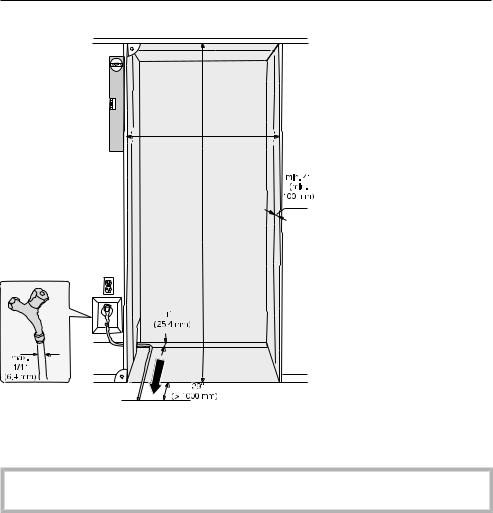
Installation
Installation dimensions
-The electrical connection must not be positioned higher than 9" above the floor.
-The 1/4" plumbed water connection (not supplied) should not be positioned higher than 2" above the floor.
The electrical outlet must not be concealed behind the appliance and must be
easily accessible in an emergency!
21

Installation
KF 2981 Vi
≥ |
|
||
(≥ |
24 |
3/4" |
|
629 |
|||
|
mm) |
||
|
|
||
|
–85 |
3/16" |
|
84" |
|
mm) |
|
34–2164 |
|
||
|
|
||
(21 |
|
|
|
36" |
(915 |
mm) |
|
||
|
|
 1 3/16" (30 mm)
1 3/16" (30 mm)
9 5/8" |
7/8" |
||
(22 mm) |
|||
(244 mm) |
|||
|
|
||
x x/x" |
4" |
4" |
|
(85 mm) |
|||
(102 mm) |
(102 mm) |
||
|
Side view
22

Installation
Dimensions when the appliance door is open (opening angle 90°/115°)
36" (915 mm) |
|
|
35 3/4" (908 mm) |
|
|
1/8" (3 mm) |
1/8" (3 mm) |
|
11 1/4" |
|
24" |
(286 mm) |
|
(610 mm) |
4" |
|
|
(102 mm) |
3/4" – 1 1/2" |
|
|
(19 – 38 mm) |
|
1/8" (3 mm) |
17 5/6" (453 mm) |
|
|
19" |
|
|
(483 mm) |
19 3/4" |
|
|
(502 mm) |
* The dimensions of the cabinet front and the door handle vary depending on the design of the kitchen.
23

Installation
Dimensions of the cabinet front
KF 2981 Vi
35 3/4" (908 mm) |
|
17 13/16" |
17 13/16" |
(452,5 mm) |
(452,5 mm) |
|
1/8" (3 mm) |
|
51 3/8" |
|
(1304 mm) |
|
79 7/8" |
|
(2029 mm) |
1/8" |
|
(3 mm) |
|
|
28 7/16" |
|
(722 mm) |
|
≥ 4" – 5 3/16" |
|
(≥ 102 – 132 mm) |
24

Installation
Building in the appliance
Before starting...
It is essential to read these installation instructions carefully before starting to install the appliance.
The appliance should be installed by a suitably qualified tradesman in accordance with these installation instructions. Safe operation of the appliance is only assured if it has been installed and connected in accordance with the installation instructions.
Risk of damage and injury!
This appliance is very heavy and can tip forwards when the door is open. Keep the appliance door shut until the appliance has been built in and secured in its housing in accordance with the operating and installation instructions.
The appliance is both large and heavy. Installation must be carried out by two people.
The appliance must be installed in accordance with local regulations. If local regulations are not available, the following regulations must be observed:
-in the USA: the National Electric Code, ANSI/NFPA 70 - latest edition/ State and Municipal codes and/or local codes.
-in Canada: the Canadian Electric code C22.1 - latest edition/Provincial and Municipal codes and/or local codes.
25

Installation
Tools required
-Cordless drill
-TX 20 screwdriver
-Hammer drill
-Drill bits in various sizes, depending on materials
-Hammer
-Open-ended wrench
-Ratchet wrench, attachment: socket, 5/16" (8 mm)
-Adhesive tape
-Utility knife
-Pipe wrench
-Level
-Tape measure
-Pencil
Other
-Step ladder
-Hand truck
Weight of cabinet fronts
Before installing the cabinet fronts, make sure that they do not exceed the maximum permitted weight:
Appliance |
Max. |
Max. |
|
weight of |
weight of |
|
upper cabi- |
lower cabi- |
|
net fronts |
net front |
|
|
|
KF 2981 Vi |
Left 150 lb |
19 lb (9 kg) |
|
(68 kg); |
|
|
right 154 lb |
|
|
(70 kg) |
|
|
|
|
Risk of damage due to weight of cabinet front.
Cabinet fronts that exceed the permitted weight can damage the hinges, and this can affect various factors, such as operation of the appliance.
Always observe the permissible weight of the cabinet fronts.
26
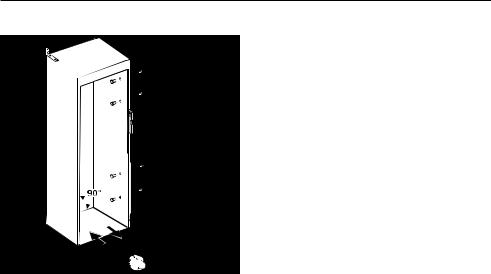
Installation
Aligning the installation niche
The building-in niche must be carefully aligned using a spirit level before the refrigeration appliance is installed. The niche corners must be at 90° angles to each other, otherwise the cabinet front will not sit straight on all 4 corners of the building-in niche.
Checking the installation space
Check the installation dimensions.
Check the position of the electrical and plumbing connections.
Check that all adjacent cabinets / units are securely fixed to the wall.
Check the adjacent cabinets / units for possible collisions when opening doors (door opening angle).
27
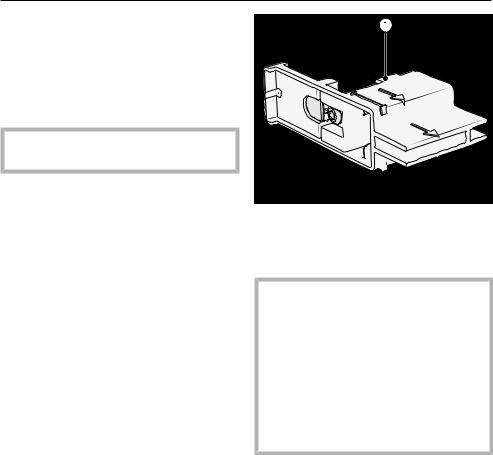
Installation
Before installation
Before installation, remove any accessories from the back of the appliance.
Check the refrigeration appliance for damage during transportation.
Do not install a damaged refrigeration appliance.
Check that all parts at the back of the appliance are unhindered.
To protect the floor during installation, secure an off-cut of flooring or similar material to the floor in front of the installation area.
Do not remove the installation aids from the appliance door. These will be required later for aligning the appliance in the building-in niche.
Risk of damage and injury due to the refrigeration appliance tipping over.
As soon as you unscrew the brackets that fix the refrigeration appliance to the pallet, the appliance is no longer secured.
Due to its weight and size, the refrigeration appliance must be installed by two people.
28
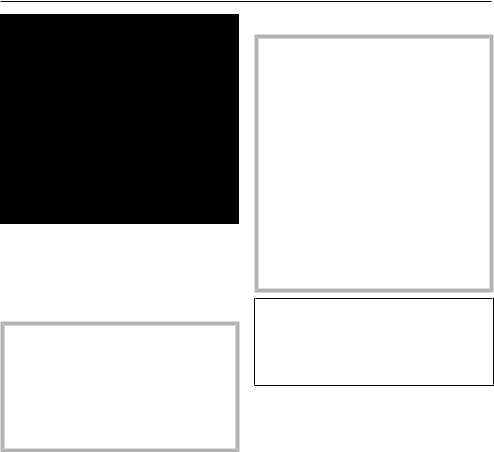
Installation
Unscrew the fixing brackets .
With the help of several people as required, carefully lift the refrigeration appliance from the pallet, starting with the back of the appliance.
Risk of damaging the floor from the load.
Moving the refrigeration appliance can cause damage to the floor. Move the refrigeration appliance carefully on floors that are sensitive to scratching.
As soon as you have set the appliance upright, you can move it using the rollers on the bottom.
Preparing the installation niche
Risk of damage and injury due to the refrigeration appliance tipping over.
This refrigeration appliance is very heavy and can tip forwards when the doors are open.
The building-in niche must be secured to the wall behind it and/or above it with several screws. Only this will prevent the refrigeration appliance from tipping over after being installed.
In addition, use the provided anti-tip brackets to secure the building-in niche.
The parts required for installation are supplied with the refrigeration appliance. The plastic bags supplied are marked with letters for easy identification.
When performing the individual assembly steps, observe the letters specified and use the matching plastic bag with the required installation equipment.
29
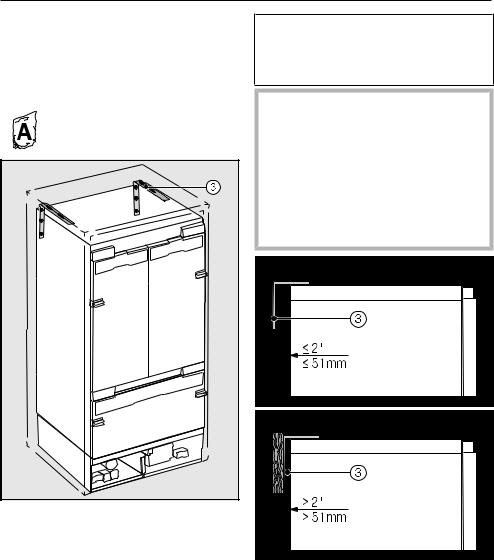
Installation
The anti-tip brackets prevent the refrigeration appliance from tipping.
The anti-tip brackets are also used to fix the building-in niche securely to the surrounding walls.
Use 2 anti-tip brackets for each individual appliance or 4 anti-tip brackets for each (side-by-side) combination of 2 appliances.
Position the anti-tip brackets on the left and right of the building-in niche.
Depending on the subsequent adjustment of the feet, the anti-tip brackets are positioned 7'-7' 1 3/4" (2134– 2164 mm) from the floor of the niche.
Risk of injury and damage due to tipping refrigeration appliance.
If the anti-tip brackets are fixed too high up, they cannot be used to secure the refrigeration appliance.
The distance between the
anti-tip brackets and the refrigeration appliance must not exceed
5/16" (8 mm).
Make sure that the gap between the refrigeration appliance’s rear wall and the building-in niche does not exceed 2" (51 mm).
Place a wooden wedge behind the anti-tip brackets if necessary.
30
